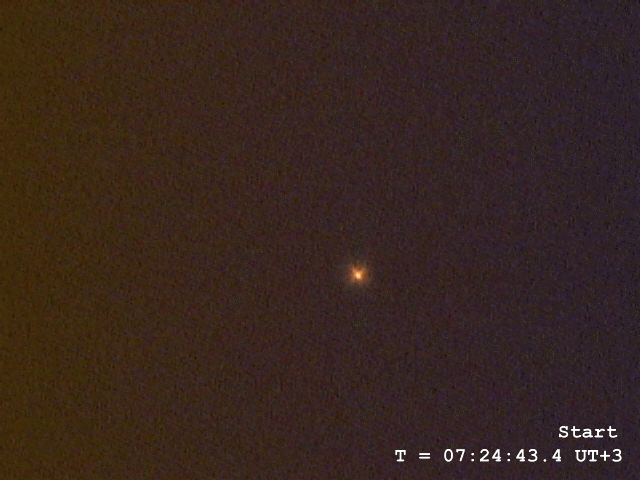
Although occultations can occur in a variety of ways, the heavenly body most often involved is our moon which inevitably
will occult (or eclipse) background stars, other planets as well as asteroids. The study of occultations is important, for
example, for the study of the moon's limb and its profile thanks to the grazing of lunar features such as mountains.
Without doubt, the most stunning example of the moon occulting another body is that involving the sun which, of course,
leads to a solar eclipse. This special example of an occultation is available
elsewhere on this site.
What is perhaps more interesting and certainly most challenging is the observation and/or imaging of the occultation of
a star by an asteroid, for these events occur along very narrow footprints and last from fractions to a handful of
seconds. These events are particularly informative scientifically since the absence or presence of an occultation from a
particular location is equally meaningful and helps provide an indirect assessment of the asteroid's size and, more
importantly, shape as well as the possible existence of associated satellites.
Note: The asteroidal occultation below was particularly challenging due to the fact that it
occurred with the sun a mere three degrees below the horizon and rising. To this end, a combination of filters
effectively yielding a longpass H-á transmission line were used to mitigate the effects of the bright sky while
simultaneously permitting a viable opportunity to record this event which was predicted to last a mere 1.1 seconds at
the center of the overhead pass (the imaging was performed six kilometers from the predicted occultation path center but
well within the predicted footprint). Further details in relation to this occultation are available on the IOTA website
here whereas occultation maps for Europe and Greece are
available here and
here, respectively.
The occultation for this particular location was predicted to be at 07:24:42 UT+3. As a precautionary measure with
respect to a possible error in the predicted time, however small or large, the imaging was initiated at 07:23:00 UT+3
and allowed to run until 07:26:00 UT+3 so that errors slightly in excess of a minute on either side of the predicted
time would not have impacted the successful imaging of the event.
Note: The maximum occultation duration was predicted to be 1.1 seconds. However, the video
clip below represents an occultation duration of 2.05 seconds and in spite of the fact that the observing location was
6 km north of the predicted occultation center. The animation below is based on five key frames: (1) Regulus immediately
prior to ingress; (2) ingress stage by Rhodope; (3) complete occultation; (4) egress by Rhodope; and (5) Regulus
immediately after egress.
|
Proper Star Name: Regulus Bayer Letter: á Leonis SAO Catalog: SAO 98967 RA / Dec: 10h 08m 22.31s / +11° 58' 01.9" Magnitude: 1.40 Proper Asteroid Name: (166) Rhodope Diameter: 35 km (0.016") Magnitude: 15.4 Occult. Max Duration: 1.1 sec Occult. Footprint: 37 km |
 |
Date: Oct 19, 2005 07:24:42.40 - 07:24:46.45 UT+3 Location: Athens, Greece Equipment: AP 160 f/7.5 StarFire EDF TeleVue 2X Big Barlow Losmandy G-11 GEM Philips ToUCam PCVC 740k Baader Red Longpass Filter Baader IR-Pass Filter Video Imaging: 1 AVI @ 20 fps (3600 frames)
Software: K3CCDTools V2.4.9.895 HandyAVI V1.7 AVI2BMP V0.49c (US) GIF Cons Set Pro V2.0a Processing: Selective Sampling (81/3600) AVI to BMP Conversion Animated GIF Construction |